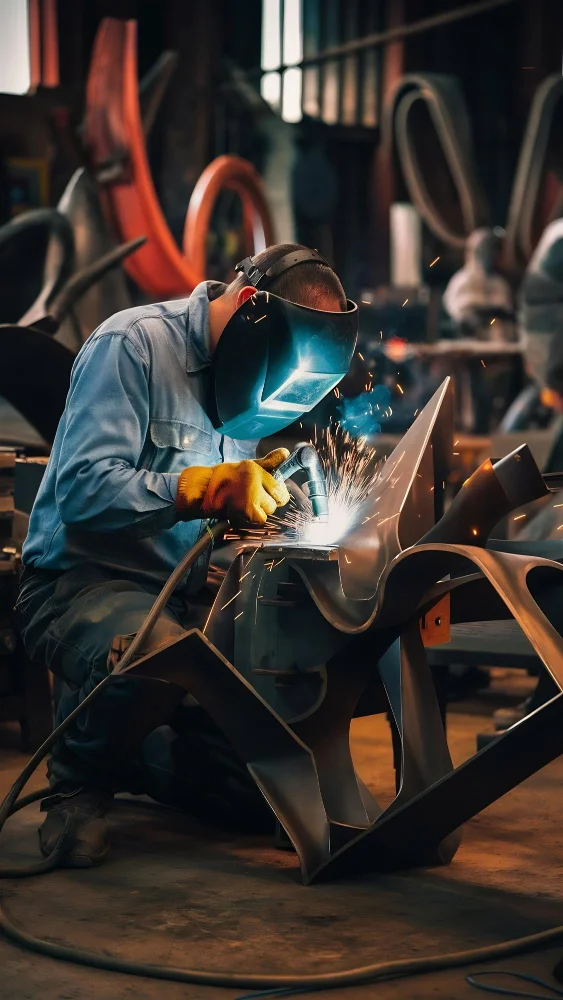Introduction
Stellite welding is a unique process used to join two different metals together. Developed in the early 1900s, stellite alloys are known for their exceptional hardness, wear resistance, and ability to withstand extreme conditions. This makes stellite welding essential in industries like aerospace, automotive, and medical applications.
The Stellite Welding Process
Stellite welding involves several key steps:
- Cleaning: The surfaces of the metals to be welded are cleaned using a wire brush or sandpaper to remove any dirt or oxidation.
- Pre-heating: The metals are heated to their optimal temperature to ensure a strong bond.
- Welding: In a vacuum chamber, an arc heat source or laser beam melts and fuses the metals. This can be done manually or with automated machines.
- Cooling: The welded pieces are cooled slowly to prevent cracking.
- Post-Weld Processing: Techniques like polishing, grinding, machining, plating, coating, sandblasting, and painting are used to improve the weld’s strength and appearance.
Technical Specifications and Properties
Stellite alloys, particularly Stellite® 6, are cobalt-based and contain 27%-32% chrome, 4%-6% tungsten, 1%-2% carbon, 3%-4% nickel, 1%-2% silicon, and 3%-4% iron. These elements give stellite its remarkable properties:
- Hardness: Ranges from 36-45 HRC on the Rockwell scale.
- Wear Resistance: Excellent resistance to wear, abrasion, and scratches.
- Corrosion Resistance: Effective even at high temperatures.
- Thermal and Electrical Properties: Good thermal conductivity and electrical resistivity.
Applications of Stellite Welding
Stellite welding is used in various industries for different applications:
- Aerospace: Engine components that must withstand high temperatures.
- Automotive: Parts that require durability and strength.
- Medical: Dental prostheses and heart valve components.
- Industrial: Valve seats, pump shafts, and cutting tools.
Advantages and Disadvantages
Advantages
- Durability: Stellite welds are incredibly strong and resistant to wear and corrosion.
- Versatility: Can join different metals, making it useful for various applications.
- High-Temperature Resistance: Maintains properties at elevated temperatures.
Disadvantages
- Cost: Stellite alloys and the welding process can be expensive.
- Machining Difficulty: Hard to machine or grind due to its extreme hardness.
- Thermal Distortion: Risk of cracking if not cooled properly.
Comparative Analysis
Compared to other welding methods, stellite welding offers superior wear and corrosion resistance. It is often chosen over stainless steel or aluminum welding for high-stress applications where failure is not an option.
Innovations and Future Trends
Recent advancements in stellite welding include the development of High-Velocity Oxy-Fuel (HVOF) spraying, which applies stellite coatings without altering the base material’s properties. This method reduces thermal distortion and increases the range of base materials that can be used.
Practical Tips and Best Practices
- Preparation: Ensure surfaces are clean and pre-heated properly.
- Safety: Always follow safety protocols to avoid accidents.
- Troubleshooting: Address common issues like cracking by controlling cooling rates and using appropriate welding techniques.
Visual Aids
For a better understanding, refer to diagrams and videos illustrating the stellite welding process and equipment. Infographics can help summarize key points and benefits.
References and Further Reading
For more detailed information, you can refer to academic papers, industry reports, and authoritative sources. Some recommended readings include:
- “Welding Metallurgy and Weldability of Nickel-Base Alloys” by John C. Lippold and Damian J. Kotecki.
- “Welding Handbook, Volume 1: Welding Science and Technology” by the American Welding Society.
Conclusion
Stellite welding is a powerful technique for joining different metals while maintaining exceptional strength and durability. Its applications in high-stress environments make it invaluable across various industries. By understanding the process, properties, and best practices, you can leverage stellite welding to achieve superior results in your projects.






















+ There are no comments
Add yours